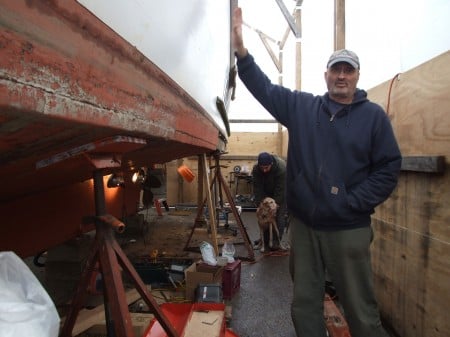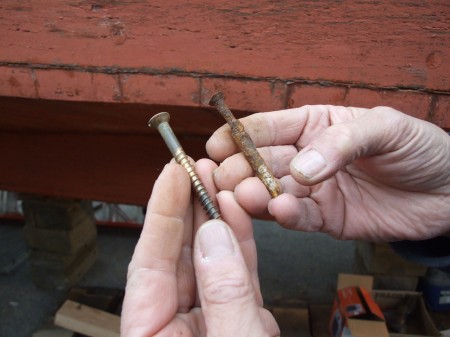Knowing when to tear the bottom off your boat

Capt. John Lipscomb describes boat repairs. In the background: Chris Brennan, boat builder, and his 12-year-old dog Tobi.
View more images on our Flickr site
Riverkeeper’s patrol boat—an icon of the Hudson, and an essential tool in our organization’s work to protect the river—sits under a temporary tent on the Ossining waterfront, a yawning hole in its bottom, and a growing collection of rusty plank nails accumulating beside it.
To the untrained eye, it looks bad. After all, it’s these nails that hold the cedar planks to the bottom and prevent the boat from taking on water. And those rusty fasteners are worn so thin it’s hard to imagine them as the sturdy galvanized steel they once were.
“When a fastener fails and a plank comes loose on a wooden boat underway, you spring a plank and then you sink very fast,” Capt. John Lipscomb said.
In reality, exposing the boat to this treatment is preventative. As Capt. Lipscomb racked up miles on patrol—about 5,000 in 2012, and about 60,000 over his 12 years on the job—the R. Ian Fletcher takes on no significant water. Replacing the plank fasteners now could prevent an emergency that jeopardizes the boat, or puts it out of commission during the patrol season.

Capt. John Lipscomb describes boat repairs. In the background: Chris Brennan, boat builder, and his 12-year-old dog Tobi.
“This is a 30-some-odd-year-old boat, and we’re seeing that that is the life of these galvanized fasteners,” said Chris Brennan, owner of Brennan Boatbuilding, and the wooden boat expert charged with replanking the boat, a project that will consume this and for several winters to come. “The whole boat will have a brand new bottom by the time we’re done.”
 Riverkeeper is asking our members and the public to help fill the coffers to offset the cost of this work. In all, the boat, its repairs, and the program it supports will cost about $40,000 this winter. We’re trying to raise $40,000 before Capt. Lipscomb launches the boat again this spring. Please make a tax-deductible donation today to support this work. All those who give $1,000 or more will be invited to join Capt. Lipscomb on the boat, and all those who donate $250 or more will be entered to win an invitation.
Riverkeeper is asking our members and the public to help fill the coffers to offset the cost of this work. In all, the boat, its repairs, and the program it supports will cost about $40,000 this winter. We’re trying to raise $40,000 before Capt. Lipscomb launches the boat again this spring. Please make a tax-deductible donation today to support this work. All those who give $1,000 or more will be invited to join Capt. Lipscomb on the boat, and all those who donate $250 or more will be entered to win an invitation.
Connie Sargent, a Riverkeeper member who lives in Brooklyn said going on patrol with Capt. Lipscomb last year was an inspiration. “First of all, John himself is a very knowledgeable and passionate speaker on behalf of the water. He is such a convincing person on any topic related to the Hudson River and the watershed. Second of all was the majesty of being out there. It’s one thing to talk about it. It’s another to be in it—in the middle of it, so beautiful and so important. The whole world looks different when you’re on the water.”
The boat undergoes routine maintenance throughout the year. “Every two hundred engine hours, it gets a whole day in the engine maintenance spa,” as Capt. Lipscomb says. Chris Brennan, calls Capt. Lipscomb’s maintenance “unrivaled”—perhaps not surprising considering his day job prior to joining Riverkeeper was the manager of Peterson’s Boat Yard in Upper Nyack. “He knows what it takes,” Brennan said. “It makes my job easier—and it puts years of life on the boat.”
That—putting years of life on a 30-foot wooden boat—is Capt. Lipscomb’s goal. In addition to the re-planking this winter, the boat will undergo soup-to-nuts maintenance, including painting, work on electronics systems and restocking. Reams of oil-absorbent pads are stocked beside the boat, a reminder of the boat and its captain’s role in preventing, investigating and stopping pollution. For a sense of how varied, extensive and important the work done by boat is, take a look at the map below.
“Every year the boat keeps going,” Capt. Lipscomb said, “recognition by the public goes up exponentially.”
Please help keep Riverkeeper’s eyes on the water by making a donation today.
Patrol Boat Highlights, 2012
View Riverkeeper Patrol Boat Highlights, 2012 in a larger map

